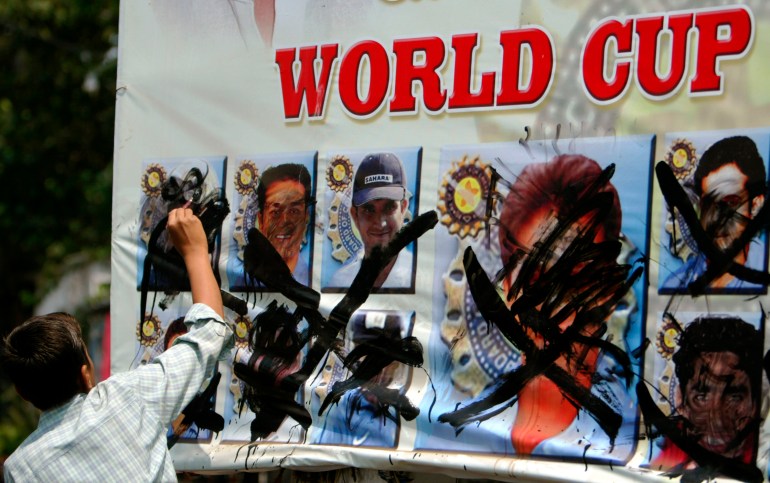World Cup 2023: Can cricket finally go global?

Why has cricket not become global yet?
Unlike football, playing cricket involves high expenditure – be it buying the necessary gear, setting up stadiums or maintaining pitches. “Cricket has a relatively high barrier to entry compared to most sports, simply due to the level of equipment required to play even a recreational game,” said Matt Roller, assistant editor at the ESPNCricinfo website. “In my view, that is the principal reason that football has long been a global sport: All you need is a ball and any small space.” But there are other reasons, too, behind cricket’s failure – by and large – to expand beyond its traditional markets, believe some experts. One key factor? The sport’s roots. Jamie Alter, a cricket analyst and journalist, said that cricket’s foundations in colonialism mean the very fabric of the sport is tied to Commonwealth countries. “The game is too intrinsic to the cultures of most of these countries, and despite the efforts of the ICC to expand cricket across the globe, it remains a rather limited sport since it relies on too few countries to properly thrive and expand,” Alter said. Traditionally cricket-loving nations like India, Pakistan and Bangladesh alone constitute a market of nearly two billion people. “Even more insular is the strength of cricket from a commercial perspective,” he added, referring to the economic clout of India and developed cricket-playing countries like England and Australia. That insularity can blunt any sense of urgency to expand the sport’s reach among administrators. Still, it isn’t as though the pool of nations that play cricket has remained entirely stagnant. Though there are records of the British playing cricket in Afghanistan in the 19th century, the sport really took off in the war-torn nation among refugees who played in camps in Pakistan in the past two decades. Then, in its first-ever 50-over World Cup in 2015, the Afghan side beat Scotland. In 2019, the country received test status – the pinnacle of the sport – and soon defeated two other test nations: Bangladesh and fellow greenhorn, Ireland. Afghan players are now regulars in T20 franchise leagues across the world. But there is little to suggest that the sport’s bosses have plans in place to replicate Afghanistan’s success. In fact, some experts believe that administrators are wary of upstart teams upsetting major nations with big markets, especially in events like the World Cup.
‘Growing very slowly’
Cricket World Cups have often attracted criticism over their small pool of participating teams. The World Cups are poorly designed – too long and with too few teams – said Tim Wigmore, deputy cricket correspondent for The Daily Telegraph newspaper. The 10-team World Cup in India will have 48 matches spanning 46 days. The 2022 football World Cup in Qatar had 32 teams and yet ran for less than a month. “Cricket has been incredibly conservative in the number of teams it has allowed in World Cups,” Wigmore, co-author of the book Crickonomics, said. And the reasons are not entirely innocent, according to him. In 2007, the 50-overs World Cup had 16 teams. But Ireland defeated Pakistan and Bangladesh beat India, pushing the South Asian nations out of the competition at the group stage. Wigmore believes the number of participating nations was “perversely” reduced in subsequent tournaments “to ensure that sides from bigger markets had more games”. Like the men’s game, the women’s World Cups also feature very few teams. The first edition of the Women’s World Cup featured seven teams in 1973, and the participation fluctuated over the years, reaching the highest count of 11 in 1997. The latest Women’s World Cup in 2022 featured eight teams and the next edition in 2025 will also have the same count. “So allowing more teams is long overdue – though this year’s ODI World Cup still only has 10 teams and the number in the women’s World Cups is only growing very slowly,” Wigmore said. ODIs – One Day Internationals – are 50-over-a-side matches between international teams. Georgie Heath, a cricket commentator and presenter, said that the World Cups also need to be marketed in the right way to attract new fans. “So much advertising seems to be targeted at those who are already cricket fans and are going to watch or attend games anyway. There needs to be more focus on how they are going to bring in new audiences, players and fans and what the sport offers them,” Heath said. “Often only being on pay-to-view television is a barrier to expansion, too, and this is something that needs to be addressed as well as some of the extortionate prices often charged for tickets.” A chaotic ticketing system at the World Cup that’s about to begin has frustrated fans. Ticket prices range from 499 rupees ($6) to 40,000 rupees ($481) on BookMyShow, the official ticketing platform. Rates in the resale market are exorbitant, with the most expensive ticket for the highly-anticipated India vs Pakistan match selling for 25 million rupees ($300,545) on Viagogo, a multinational ticket exchange and ticket resale brand. Meanwhile, questions over the very survival of the ODI format are mounting.
The future: 20 or 50 overs?
In July, the Marylebone Cricket Club (MCC) – the custodians of the game’s laws – recommended limiting the number of ODI internationals following the 2027 World Cup. The suggestion comes at a time when the 50-over format is losing its relevance: Longer, five-day test matches remain the priority for traditional fans, while casual viewers have embraced a quicker and glitzier 20-over-a-side format that has spawned multiple franchise leagues. Cricketers themselves are less convinced that it is time to bid farewell to ODIs. A report in 2022 by the Federation of International Cricketers’ Association, the global body that represents players, said that 54 percent of cricketers still consider the ODI World Cup as the top trophy to compete for, though the number had reduced significantly from 86 percent in their 2018-19 survey. “My view is that one-day cricket will be played less and less at the international level, but that the World Cup will remain a pinnacle event that players aspire to be part of,” Roller said. “The general issue for 50-over cricket is that bilateral international cricket is increasingly being squeezed by franchise leagues – and private investors clearly have limited interest in the idea of 50-over leagues, seeing the speed of games as a key component of short-form cricket’s appeal.” To Roller, the T20 World Cup – held every two years – is a “much clearer vehicle for growth”. With next year’s T20 World Cup set to feature 20 teams, its biggest pool of participants so far, Wigmore, the cricket writer and author, expects the tournament to be a big catalyst for cricket’s growth. But it won’t be easy. Lower-ranked teams are likely to struggle to remain competitive as they receive a very limited share of central broadcast revenue from the T20 World Cup, Roller pointed out, limiting the resources that they can funnel back into popularising the sport. “Staging the tournament every two years also risks killing the golden goose: the scarcity of World Cups in other sports helps add to their prestige,” he added. Other analysts believe the future lies in T20 cricket – not so much in international matches, but in franchise leagues.
‘Building a successful business’
In 2018, ex-ICC CEO David Richardson said that it was “quite clear” that T20 cricket would be the format by which the governing body could “globalise and grow the game worldwide”. Fast forward to 2023, and the T20 format seems to be flourishing. There are domestic and franchise leagues taking place in Africa, the Americas, Asia, Oceania and some parts of Europe. The Indian Premier League (IPL), which has an estimated brand value of $8.4bn, has built its status as the world’s top T20 competition since its inception in 2008. Lucrative leagues have also started in Australia, the United Arab Emirates, South Africa, England and Wales, Pakistan, the Caribbean and most recently in the United States. “T20 cricket has spread the sport, but for cricket to be a sustainable and global game, it’s going to be these leagues that are starting up everywhere, like in the US or UAE,” said Bharat Sundaresan, cricket writer for the Cricbuzz website. “Eventually, we’ll reach a point where if there is a window, new leagues could come up in other nations. “And that’s personally how I see cricket growing even more in a global sense,” Sundaresan said. In July, cricket broke into the world’s wealthiest market, the US, with the launch of Major League Cricket, with six teams competing in the T20 format. The MLC assembled an impressive group of investors, with four of its six franchises owned by business entities that also own teams in the IPL. The US – along with the West Indies – is also scheduled to host the T20 World Cup next year, offering an opportunity for the sport and format to grow there. “All these IPL franchise owners, whether they have the best interest of the sport in mind or not, the one thing they do know to do is to run a successful business,” Sundaresan said. “Their business is so dependent on their brand being showcased for a longer period during the year rather than just for two months, which is why they’re buying out all the teams around the world. It’s just going to lead to there being more leagues,” he added. Sundaresan also tipped women’s cricket as playing a key role in enhancing the sport’s global image. The first full-fledged five-team Women’s Premier League (WPL) earlier this year saw several female cricketers witnessing the biggest payday of their careers at the auction. Meanwhile, the FairBreak Invitational T20 held its second edition in Hong Kong this year, featuring some of the world’s best female cricketers who took part in the six-team tournament. “I think women’s cricket will popularise cricket as a sport more globally than what men’s cricket has been able to do in the last 150 years,” Sundaresan said. He cited the stunning emergence of Thailand – a country with no known history in the sport – as a petri dish of talent in the women’s game. They qualified for their first global event in 2020 when they competed at the Women’s T20 World Cup and the team has been ranked as high as 10th internationally. Thai players have also grabbed attention in franchise leagues. In 2020, opening batter Natthakan Chantham played for the Trailblazers in the Women’s T20 Challenge competition in India, becoming the first Thai cricketer to play in a professional T20 franchise league. All-rounders Nattaya Boochatham and Sornnarin Tippoch, as well as batter Naruemol Chaiwai, featured in the FairBreak Invitational T20 this year. “Suddenly, it’s a free-for-all, right?” Sundaresan said. “Like, you can be part of a national team in a country which doesn’t have a great standard of cricket, but you have a tournament to go to and play.”
